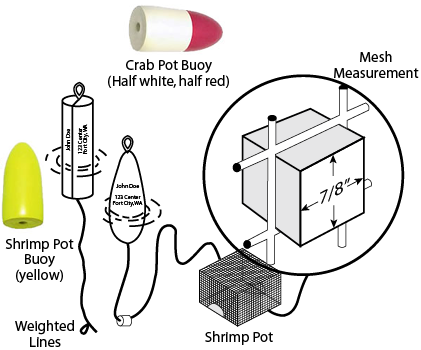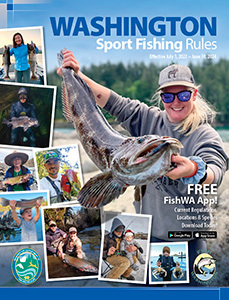Statewide Gear Rules
Caution: The requirements below are the minimum established by law. The addition of weights to traps is advised and currents in some locations may also require the use of additional buoys and extra line to prevent the equipment from being lost. Refer to the individual species listings (Crab Rules; Shrimp Rules; and Shellfish/Seaweed Species Rules) for seasons and other harvest rules. Not all shellfish gear sold in Washington meet the specifications shown on this page. Verify that your pot meets these requirements prior to use.
General Gear Rules
Crab, shrimp, and crawfish may be harvested using pots, by hand, or with a dipnet. Hand operated instruments may not penetrate the shell. Additional rules for pot use apply.
One star trap, one ring net, one castable snare, or one pot is considered one unit of gear. The maximum number of units of gear that may be fished per person is:
Puget Sound: (Marine Area 4, east of the Bonilla-Tatoosh line, and in Marine Areas 5-13).
- Shrimp: Two pots per person, and no more than 4 shrimp pots may be onboard or fished by any one boat at a time.
- Crab: Two units of crab gear per person, and no limit on the number of units of crab gear per boat.
Coastal Waters: (Marine Areas 1-3 and in Marine Area 4, west of the Bonilla-Tatoosh line).
- Two units of crab and/or shrimp gear per person.
- Exception: Columbia River - three units of crab gear per person.
Freshwater:
- Crawfish: Five units of gear per person.
Statewide Shellfish Pot Rules—Crab, Shrimp, & Crawfish
- Every shellfish pot, ring net, or star trap left unattended in Washington waters must have its own buoy line and a separate buoy that is permanently and legibly marked with the owner’s first name, last name, and permanent address (telephone number is voluntary). It is ILLEGAL to set or pull unattended shellfish gear with a buoy that does not have your name on it, and only one name and address may appear on each buoy. Any angler may assist the person whose name is on the buoy while he or she is pulling the pot.
- No fisher may set, or pull shellfish gear from a vessel, in Marine Areas 1-13, from one hour after official sunset to one hour before official sunrise. All shellfish gear must be removed from the water on closed days.
- Buoys must be constructed of durable material. It is unlawful to use bleach, antifreeze, or detergent bottles, paint cans or any other container. Buoys must be visible on the surface at all times except during extreme tidal conditions. Personal flags and staff, if attached to buoys, can be of any color. Buoy lines must be weighted sufficiently to prevent them from floating on the surface.
- All crab, shrimp, and crawfish pots must be equipped with a biodegradable device (rot/escape cord) which must be affixed to the pot in at least one of the following ways:
- Securing the pot lid hook or tie down strap with a single loop of rot cord; or
- Sewing a 3" by 5" escape panel in the upper half of pot closed with rot cord; or
- Attaching the pot lid or one pot side (serving as a pot lid) with no more than three single loops of rot cord.
Cord used must be untreated 100% cotton, hemp, jute, or sisal no larger than thread size 120 (1⁄8"). This cord, when attached as described above, must be able to rot away and allow crab, shrimp, crawfish and fish to escape freely if the pot is lost. A derelict crab pot without proper escape cord can attract and kill crabs for years after the pot has been lost.
Crab Gear:
- The minimum mesh size for crab pots is 1½", and all pots must have two 4¼" minimum inside diameter escape rings in the upper half of the pot, except in the Columbia River where the minimum ring size is 4" inside diameter.
- All parts of ring nets and star traps must lie flat on the sea bottom and may not restrict free movement of crab until lifted. Shellfish pots must be covered by water at all times while being fished.
- Crab pots must not exceed 13 cubic feet.
- All crab gear buoys must be half red and half white in color, and both colors need to be visible when fishing.
Shrimp Gear:

- Pots must be constructed of either flexible or rigid mesh material (no liners allowed).
- Entrance tunnels can be made of any size mesh material but must be located on the sides of the pot. The sum of the maximum tunnel widths must not exceed one-half the perimeter of the bottom of the pot.
- Shrimp pots must not exceed 10 feet in perimeter and 18" in height.
- All shrimp pot buoys must be yellow in color.
Shrimp Pot Mesh Size:
1" Minimum Mesh Size
A 7⁄8" square peg must be able to pass through each mesh opening – see diagram, except for flexible (web) mesh pots, where the opening must be a minimum of 1¾" stretch measure.
- Puget Sound: Required for all shrimp pots during the month of May. Required in all areas open for spot shrimp after June 1st.
- Pacific Ocean: Year-round in waters seaward of 20 fathoms.
1/2" Minimum Mesh Size
A 3⁄8" square peg must be able to pass through each mesh opening, except for flexible (web) mesh pots, where the opening must be a minimum of 11⁄8" stretch measure.
- Puget Sound: Allowed after June 1st in any area closed for spot shrimp, but open for coonstripe and pink shrimp.
- Pacific Ocean: Year-round in waters shoreward of 20 fathoms.
Lost Gear:
Do not attempt to retrieve your lost shellfish gear without first getting permission from the WDFW Enforcement Program (360) 902-2936. Permission may be granted verbally or by a permit to retrieve your gear. Salvaging gear belonging to others requires a permit. To report lost shellfish gear, use the Online Reporting Tool

